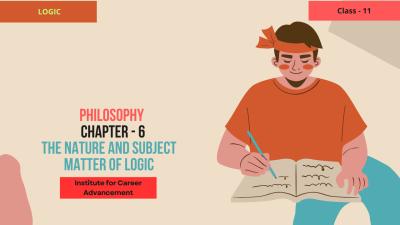The Concept and Kinds of Dharma - Class 12
Dharma is a multifaceted concept in Indian philosophy and religion, encompassing various aspects of human existence. It translates roughly to "righteousness," "duty," or "cosmic law." Key Aspects: Cosmic Law: Dharma is seen as a fundamental principle governing the universe, ensuring order and balance. It's not just a set of rules, but a cosmic law that upholds the integrity of the universe. Moral Guidance: Dharma provides a framework for ethical conduct, guiding individuals towards virtuous living. It emphasizes righteousness, compassion, and fulfilling one's duties. Social Order: Dharma plays a crucial role in maintaining social order and harmony within society. It defines the roles and responsibilities of individuals within their social groups (family, caste, etc.). Individual Liberation: While focusing on social duties, Dharma ultimately aims at individual liberation (moksha). By fulfilling one's duties according to Dharma, individuals can attain spiritual enlightenment and liberation from the cycle of rebirth. Kinds of Dharma: Svadharma: One's own unique duty based on their individual circumstances, including their caste, stage of life (ashram), and personal inclinations. Varṇadharma: Duties and responsibilities based on one's caste (Brahmin, Kshatriya, Vaishya, Shudra). Āśramadharma: Duties based on one's stage of life (Brahmacharya - student, Grihastha - householder, Vanaprastha - retired, Sanyasa - renunciation). Rājadharma: The duties and responsibilities of a king, which include maintaining law and order, protecting the citizens, and ensuring the welfare of the kingdom. Significance of Studying Dharma: Understanding Indian Culture: Dharma is a central concept in Indian philosophy and has profoundly shaped Indian culture, society, and values. Developing Ethical Frameworks: Studying Dharma provides insights into different ethical frameworks and encourages students to reflect on their own values and responsibilities. Promoting Social Harmony: Understanding the concept of Dharma can foster a deeper appreciation for social harmony and the importance of fulfilling one's duties towards society. Personal Growth: Dharma emphasizes personal growth, self-discipline, and the pursuit of a meaningful life. ধর্ম হল ভারতীয় দর্শন ও ধর্মের একটি বহুমুখী ধারণা, যা মানব অস্তিত্বের বিভিন্ন দিককে অন্তর্ভুক্ত করে। এটি মোটামুটিভাবে "ধার্মিকতা", "কর্তব্য" বা "মহাজাগতিক আইন" অনুবাদ করে। মূল দিকগুলিঃ মহাজাগতিক আইনঃ ধর্মকে মহাবিশ্বকে নিয়ন্ত্রণকারী একটি মৌলিক নীতি হিসাবে দেখা হয়, যা শৃঙ্খলা ও ভারসাম্য নিশ্চিত করে। এটি কেবল নিয়মের একটি সেট নয়, একটি মহাজাগতিক আইন যা মহাবিশ্বের অখণ্ডতা বজায় রাখে। নৈতিক দিকনির্দেশনাঃ ধর্ম নৈতিক আচরণের জন্য একটি কাঠামো প্রদান করে, মানুষকে পুণ্যবান জীবনযাপনের দিকে পরিচালিত করে। এটি ধার্মিকতা, সহানুভূতি এবং নিজের দায়িত্ব পালনের উপর জোর দেয়। সামাজিক শৃঙ্খলাঃ সমাজের মধ্যে সামাজিক শৃঙ্খলা ও সম্প্রীতি বজায় রাখতে ধর্ম গুরুত্বপূর্ণ ভূমিকা পালন করে। এটি তাদের সামাজিক গোষ্ঠীর (পরিবার, বর্ণ ইত্যাদি) মধ্যে ব্যক্তিদের ভূমিকা এবং দায়িত্বগুলি সংজ্ঞায়িত করে। ) ব্যক্তিগত মুক্তিঃ সামাজিক কর্তব্যের প্রতি মনোনিবেশ করার সময়, ধর্ম শেষ পর্যন্ত ব্যক্তিগত মুক্তির (মোক্ষ) লক্ষ্য রাখে। ধর্ম অনুসারে নিজের কর্তব্য পালন করে, ব্যক্তিরা আধ্যাত্মিক জ্ঞান অর্জন করতে পারে এবং পুনর্জন্মের চক্র থেকে মুক্তি পেতে পারে। ধর্মের প্রকারঃ স্বধর্মঃ তাদের বর্ণ, জীবনের পর্যায় (আশ্রম) এবং ব্যক্তিগত প্রবণতা সহ তাদের ব্যক্তিগত পরিস্থিতির উপর ভিত্তি করে একজনের নিজস্ব অনন্য কর্তব্য। বর্ণধর্মঃ একজনের বর্ণের উপর ভিত্তি করে কর্তব্য এবং দায়িত্ব (ব্রাহ্মণ, ক্ষত্রিয়, বৈশ্য, শূদ্র) আশ্রমধর্মঃ একজনের জীবনের পর্যায় ভিত্তিক কর্তব্য (ব্রহ্মচর্য-ছাত্র, গৃহস্থ-গৃহকর্তা, বনপ্রস্থ-অবসরপ্রাপ্ত, সন্ন্যাস-ত্যাগ) রাজধর্মঃ একজন রাজার কর্তব্য ও দায়িত্ব, যার মধ্যে রয়েছে আইন-শৃঙ্খলা বজায় রাখা, নাগরিকদের রক্ষা করা এবং রাজ্যের কল্যাণ নিশ্চিত করা। ধর্ম অধ্যয়নের তাৎপর্যঃ ভারতীয় সংস্কৃতি বোঝাঃ ভারতীয় দর্শনে ধর্ম একটি কেন্দ্রীয় ধারণা এবং ভারতীয় সংস্কৃতি, সমাজ ও মূল্যবোধকে গভীরভাবে রূপ দিয়েছে। নৈতিক কাঠামোর বিকাশঃ ধর্ম অধ্যয়ন বিভিন্ন নৈতিক কাঠামোর অন্তর্দৃষ্টি প্রদান করে এবং শিক্ষার্থীদের তাদের নিজস্ব মূল্যবোধ ও দায়িত্বগুলি প্রতিফলিত করতে উৎসাহিত করে। সামাজিক সম্প্রীতির প্রচারঃ ধর্মের ধারণাটি বোঝা সামাজিক সম্প্রীতির প্রতি গভীর উপলব্ধি এবং সমাজের প্রতি নিজের দায়িত্ব পালনের গুরুত্বকে উৎসাহিত করতে পারে। ব্যক্তিগত বিকাশঃ ধর্ম ব্যক্তিগত বৃদ্ধি, আত্ম-শৃঙ্খলা এবং অর্থপূর্ণ জীবনযাপনের উপর জোর দেয়।
English
Last updated
Mon, 06-Jan-2025



















